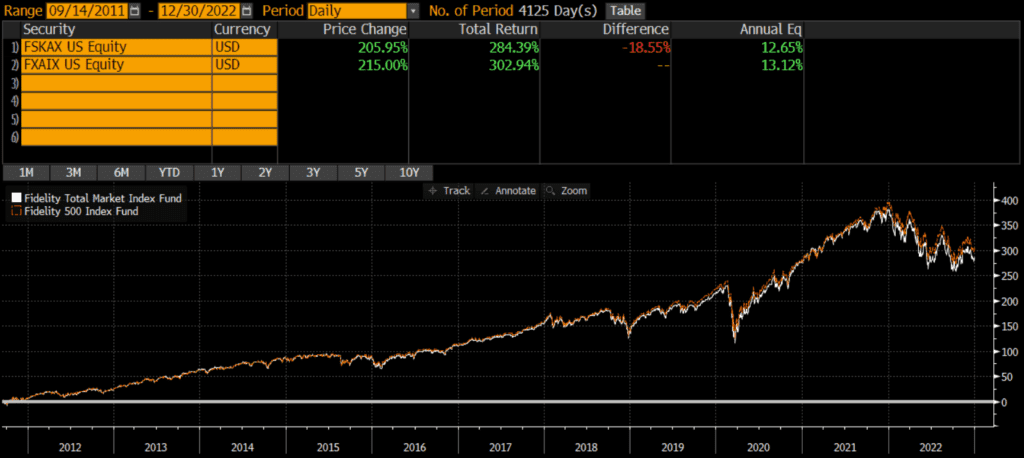The Fidelity S&P 500 Index mutual fund (FXAIX) and the Fidelity Total Stock Market Index fund (FSKAX) are two of the largest mutual funds in existence. FXAIX and FSKAX are the core of many investor portfolios. Many investors compare FXAIX vs FSKAX in order to decide which should be the foundation of their portfolio.
A quick reminder that this site does NOT provide investment recommendations. Fund comparisons (such as this one) are not conducted to identify the “best” fund (since that will vary from investor to investor based on investor-specific factors). Rather, these fund comparison posts are designed to identify and distinguish between the fund details that matter versus the ones that don’t.
The Short Answer
The main difference between FXAIX and FSKAX is that FXAIX is a large- and mid-cap fund, while FSKAX is a total market fund. Despite these differences, the total return between these two funds is pretty close.
The Long Answer
Historical Performance: FXAIX vs FSKAX
FXAIX was launched back in 1988, while FSKAX was launched on September 8, 2011 (although other shares classes of the fund existed prior to that). Since then, FXAIX has outperformed by about a half percent annually. This is not a huge performance differential, but it does compound over time. The cumulative difference between the two funds since common inception is approximately 18%.

Of course, the outperformance of FXAIX is reflective of large-cap stocks’ dominance over the past decade. If mid-caps and/or small-caps lead, then I suspect FSKAX would outperform.
Differences between FXAIX vs FSKAX
The biggest difference between FXAIX and FSKAX is the market cap exposure of the funds. FXAIX tracks the S&P 500 index which includes mostly large-caps and some mid-caps, while FSKAX covers much more of the market by including more mid-caps and small-caps.
Geographic Exposure
Both FXAIX and FSKAX hold essentially 100% stocks, so I will not dig into country exposures or market classification here. For intents and purposes, the two funds have identical exposures.
Market Cap Exposure
FXAIX focuses on the S&P 500 index and so it mostly holds large-caps with a bit of mid-cap exposure. FSKAX tracks the broader Dow Jones U.S. Total Stock Market Index and so it owns many more mid-caps and small-caps (as of 11/30/2022). In other words, FXAIX is a large-cap vehicle, while FSKAX is a total market vehicle. That being said, due to market cap weighting, both funds are overwhelmingly influenced by the large-cap holdings.
| FXAIX | FSKAX | |
| Large-Cap | 83% | 73% |
| Mid-Cap | 16% | 19% |
| Small-Cap | 0% | 9% |
Sector Weights
The sector weights between FXAIX and FSKAX are nearly identical, as of 11/30/2022. The weights are within 1% for every single sector.
| FXAIX | FSKAX | |
| Basic Materials | 2.40% | 2.68% |
| Consumer Cyclical | 10.16% | 10.43% |
| Financial Services | 13.80% | 14.04% |
| Real Estate | 2.77% | 3.46% |
| Communication Services | 7.46% | 6.91% |
| Energy | 5.12% | 5.13% |
| Industrials | 8.86% | 9.58% |
| Technology | 23.72% | 23.18% |
| Consumer Defensive | 7.40% | 6.77% |
| Healthcare | 15.31% | 14.97% |
| Utilities | 2.99% | 2.87% |
Transaction Costs
Many brokers and custodians still charge commissions and/or transaction fees to buy/sell mutual funds. To my knowledge, Fidelity does not participate in the pay-to-play arrangements (with their competitor custodians) that would allow their mutual funds to trade for free on many platforms. So if an investor account is at Fidelity, it is generally free to trade FXAIX; other custodians will likely charge a fee to trade Fidelity mutual funds.
It is worth noting that neither fund has a minimum for initial or additional investments. That being said, investors looking for free trades may want to consider an a total market ETF or large-cap ETF, rather than FSKAX or FXAIX.
Expenses
The expense ratio for both funds is both the same and extremely low (.015%).
Tax Efficiency & Capital Gain Distributions
Both funds have made capital gains distributions in the past and will likely make them in the future. It is not possible to say which one will be more tax-efficient in the future. As index funds, the tax drag on both funds is very low. However, tax-sensitive taxable investors may want to consider using an ETF in lieu of either of these funds.
Final Thoughts: FXAIX vs FSKAX
Both FXAIX and FSKAX are large, core funds sponsored and managed by one of the largest asset managers in the world (Fidelity). Beyond market cap exposures, the funds appear and act very similar. Long-term performance has been nearly identical. I view these two funds as essentially interchangeable and would not spend too much energy splitting hairs to decide which one is “better.” Overall, these two funds are very similar and I wouldn’t worry too much about picking the “right” one.